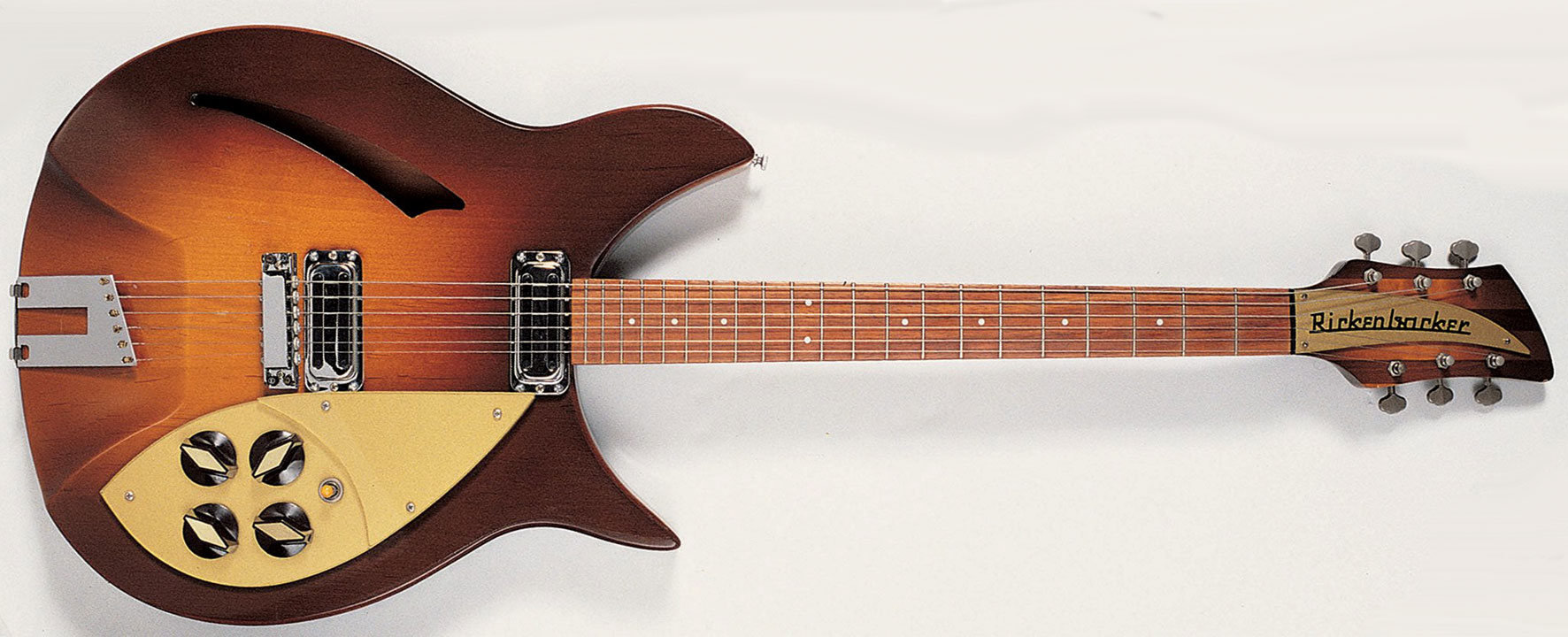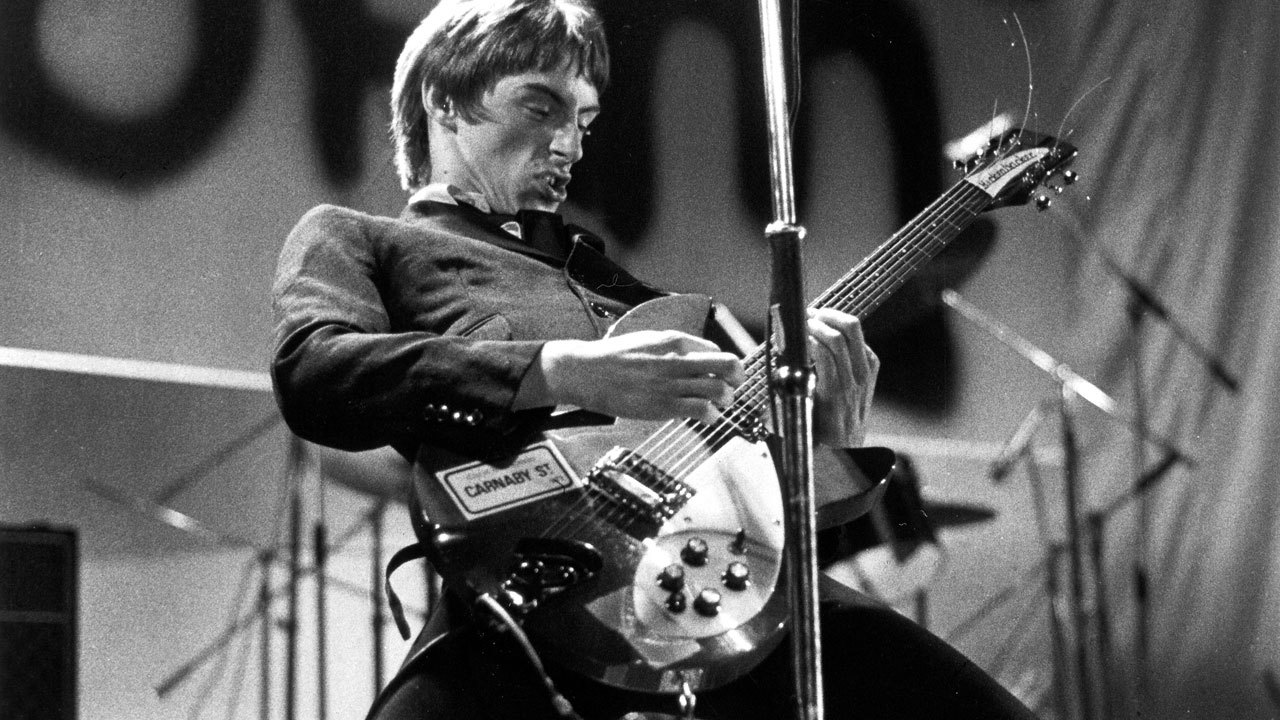The Rickenbacker 330 became an icon thanks to Paul Weller, the great unsung hero of guitar tone. Far and away the best lyric writer this country has ever produced (listen closely to Town Called Malice for pure working class poetry) he’s never received the respect he deserves as a guitarist. Not that he’s losing any sleep over it. “I don’t give a fuck about all that top 100 guitarist bollocks, mate,” he once told this writer.
These days, Weller is best known for pulling exceptional tone from his mid-60s Epiphone Casino and Gibson SG. In the late 70s and early 80s however “The Woking Wonder” took his anger out on a collection of Rickenbacker 330 models in a bunch of finishes including Fireglo (aka Rickenbacker’s sunburst), Jetglo (black), Mapleglo (natural), not to mention a very rare white example and his pop-art “Whaam!” guitar daubed with a Roy Lichtenstein graphic. The latter 330 was also modified with a Gibson humbucker chiselled into the neck position.
A devoted Lambretta-straddling mod by his teens, Weller unleashed his legendary “fire and skill” on the 330 because his idol Pete Townshend of The Who played, and ruthlessly destroyed, a slew of Rickenbacker guitars in the 1960s. While the models brandished by Townshend and Weller looked very similar they we’re actually quite different in specification. Before we go any deeper into that, let’s go back to the model’s birth.
The Rickenbacker 330, the star of the 300 series and the brand’s biggest selling model, was first launched back in 1958. At that time, the 300 series guitars were actually designated “Capri” models and like all Rickenbacker guitars they were built at the company’s factory in Santa Ana, California.

Compared to other semi-acoustics, in particular the Gibson ES-335, Rickenbacker guitars looked way ahead of their time. The 330 was designed by German luthier Roger Rossmeisl and, like other Ricky models, came spec’d with a “crescent moon” double cutaway semi-hollow maple body with “slash” f-holes, a three-ply maple/walnut glued in neck, and a 10” radius rosewood fretboard finished with varnish. That was unusual… just about every other brand leaves its rosewood ‘boards unfinished. The 330 also featured a Gibson-like 24.75” scale length and, up until a spec tweak in 1970, came loaded with 21 frets.
The semi-hollow construction also made it easy for Pete to pull serious feedback from his guitars. A screaming Rickenbacker 330 is a beautiful thing and Townshend would also rapidly flick the guitar’s pickup selector switch to get Morse Code bleeps.
It was actually Beatles John Lennon and George Harrison that put Rickenbacker tone on the map in the UK and beyond with their, respectively, shortscale Ricky 325 and 360⁄12 models… and more on those history changing guitars in another instalment. Thanks to John and George, Townshend and 12-string icon Roger McGuinn of The Byrds would pick up Rickenbackers and in turn, turn, turn, turn a bunch of kids like Tom Petty, REM’s Peter Buck and ex-Smith Johnny Marr onto that “jingle jangle” sound.
Of course, as many guitarists have bought Ricky 330s over the years because of Paul Weller, although unlike Townshend and McGuinn he’s never had the signature model he deserves. At the very least he shoulda got some commission. Weller’s 70s models featured a series of spec tweaks over the 60s guitars Pete T owned. For a start, Rickenbacker bumped the fret count up from 21 to 24 in 1970. You might recall that Black Sabbath’s Tony Iommi campaigned to get a 24-fret SG in the early 70s but was told it couldn’t be done. Luthier John Birch eventually accepted the challenge and made his dreams come true. Well, Ricky already had that one in the bag, although the notion of Iommi bashing out War Pigs on a 330 is hard to swallow… even a black one.
Clip: Tom Petty plays Free Fallin’ on his 60s Rose Morris model 1997 330 (song runs from 14.40 to 19.30)
Weller’s 330s’ possessed the eye candy that is the heavier chrome “R” tailpiece but, more importantly, featured the more powerful “High-Gain” humbuckers that debuted in the early 70s. These pickups provided plenty of grunt but crucially, although less jangly than the “Toaster Tops”, they retained the clarity that the 330 had become famous for thanks to that maple body and neck In other words, even through a heavily-distorted amp, the note separation was exceptional.
Clip: Weller demonstrates the 330’s exceptional note separation on Eton Rifles (example runs from 1.40 to 1.60)
The 330’s maple construction gives it a naturally bright tone but Weller and Jam producer Vic Coppersmith-Heaven boosted that razor sharp delivery with a clever studio trick. To get the outstanding tones on The Jam’s Setting Sons album and singles like Going Underground, Coppersmith-Heaven built a corrugated iron enclosure around Weller’s amp. The result was the explosive metallic report heard on those records.
When The Jam split in 1982, Paul Weller hung up his 330s. He eventually gifted his Jetglo Going Underground 330, with its custom black pickguards and Gibson-style stop tailpiece, to bandmate and Ocean Colour Scene guitarist Steve Cradock. His rare white 330 went to Noel Gallagher.
- The Guitars That Built Rock: The Gibson ES-335
- The Story Behind The Song: Jools And Jim by Pete Townshend
- Buyer's Guide: Paul Weller
- The Guitars That Built Rock: The Fender Telecaster
The 330 is still in production today, in six and 12-string formats. It’s essentially the same guitar that Weller played in The Jam days. On occasion, Rickenbacker produce limited runs of the Rose Morris style guitars they flogged to Pete Townshend back in the day, the ones with the lower output “Toasters”. Why is the model still so popular? Well, history was made on these things. No other guitar sounds like a 330 - although a sorted Fender Tele can get reasonably close - and nothing is quite so evocative of various eras of classic power pop from The Who to The Smiths. Rickenbacker 330s are flawlessly finished, playable works of art that still cost less than two grand; that’s about a third of the lolly required for a restored 60s Lambretta SX200 mod scooter. The guitar is so highly regarded almost 60 years after its birth that not even Pete Townshend smashes them up anymore.

